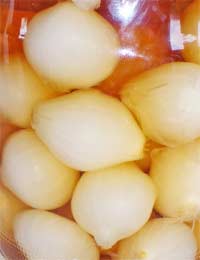
If you have an onion glut – or even if you don’t – then pickling is the answer. Making your own gives you the opportunity to choose your own flavourings for the pickles, and avoid additives that are sometimes found in commercially pickled onions. Here’s our expert guide to help you get it right first time.
What You’ll Need…
Before you pickle, assemble your onions. Oh, and you’ll need a few other things, too:
Shallots or onions – Shallots are usually sweeter than onions, even the ‘pickling’ varieties, and can be obtained in different shapes and sizes. There are French shallots, with a slender form, and Dutch shallots, with a round, traditional shape. Growing your own gives you the greatest choice, and it’s so easy. This year, when you’re pickling, order some onion sets for next year. Plonk them into a bed and let them slowly grow until spring, when you can lift and dry them.
Salt. Ordinary table salt is fine for the initial brining (see below). For a clearer finish in your pickles, use sea or brining salt.
Vinegar. You can use Sherry Vinegar (which Delia likes), Malt Vinegar (the traditional choice), White Wine Vinegar, or Distilled Malt Vinegar (for a clearer finish). Why not try a jar of each?
Pickling Spices (flavourings). This refers to a versatile mixture of spices that can be tailored to your own preference. Buy a pre-mixed batch from the supermarket (or, for an organic blend, from Steenbergs) or mix your own using dried chillies, mustard seeds, peppercorns, cloves, mace, or coriander seed. Just 1tsp of this mix will be enough for a 1/2lb jar of onions. If you’re experimenting with these flavourings, just use a little – don’t risk over-spicing the whole batch.
1: Brining your Onions
Pickling is a two-day process – but don’t worry, the work is actually quite minimal. The worst of it occurs at the start, when you have to peel and soak the onions. Before you begin to peel and trim them, prepare a large bowl of salty water (brine). This draws moisture out of the onions and softens them ever so slightly before pickling. (A dry brine is used when crisper onions are required.) Mix 2tbsp salt in boiling water, stir to dissolve, then top up to 1 pint with cold water. Multiply these proportions to give enough brine to cover all of your onions. Drop the peeled onions or shallots into the brine, cover loosely, and leave overnight (up to 24 hours). The onions will become too soft if left for longer than 24 hours. After this time, drain the onions, rinse thoroughly with clean water, and leave to drain as much as possible.
2: Preparing the Vinegar
Use 1tsp spices per pint of vinegar. Choose a stainless steel saucepan (not copper or aluminium, which taint the flavourings). Bring to a gentle boil and simmer softly for about 5 minutes, or a little longer for stronger flavour. Pass through a sieve to remove the spices, if wished, then set this pickling vinegar aside to cool. (Leaving the spices in the vinegar will allow a stronger flavour to develop over time.)
3: Sterilising the Jars
Sterilise your jars by washing in warm soapy water, and putting into a low oven (preheated to 100 degrees, then switched off) to dry. Allow them to cool slightly before bottling the onions, or the glass may shatter.
4: Bottling and Labelling
For sweeter pickles, put a teaspoon of sugar in the bottom of the jar, and add a little vinegar to dissolve it. Then continue: Simply layer your onions in the jar, leaving a little gap at the top, then cover completely with the cooled vinegar. Tap the jar gently to get rid of air bubbles, and make sure the onions are covered before sealing the jar. Add your own labels and optional ribbon if the jars are intended as gifts.
